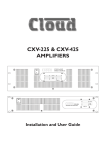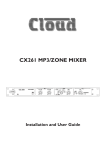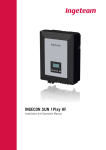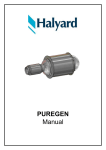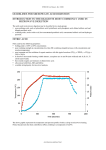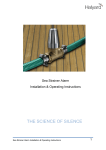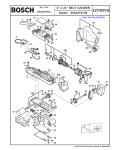Download VTX Manual
Transcript
VTX Amplifiers Installation & User Guide V3.0 Cloud Electronics Limited 140 Staniforth Road, Sheffield, S9 3HF England Tel + 44 (0) 114 244 7051 Fax + 44 (0) 114 242 5462 E-mail [email protected] Web site http://www.cloud.co.uk VTX Amplifiers: INSTALLATION AND USER GUIDE 1 1 Safety Notes • • • • • Do not expose the unit to water or moisture Do not expose the unit to naked flames. Do not block or restrict any air vent Do not operate the unit in ambient temperatures above 35oC Do not touch any part or terminal carrying the hazardous live symbol ( ) while power is supplied to the unit. • Do not perform any internal adjustments unless you are qualified to do so and fully understand the hazards associated with mains operated equipment. • The unit has no user serviceable parts. Refer any servicing to qualified service personnel. • If the moulded plug is cut off the lead for any reason, the discarded plug is a potential hazard and should be disposed of in a responsible manner. For more detailed information refer to the rear of the manual. 2 General The VTX amplifiers are a range of rugged, high quality, professional power amplifiers designed to give long, reliable service when continuously operated at high power levels. All models feature very low distortion and noise together with a high slew rate. A comprehensive range of protection circuits including Cloud’s DCP (Dynamic Clip Protection) allows the amplifiers to tolerate a good deal of abuse and help prevent damage to speakers. 3 Installation These amplifiers occupy three units (i.e. 5.25"/133mm) of standard 19” rack space and are 330mm deep; though 410mm should be allowed to clear the connectors. All three amplifiers are force cooled with cool air drawn in from the front and exhaust from the rear which enables any number of amplifiers to be racked without the need for special ventilation, provided that a free flow of air is available at the rear of the rack housing. 4 Input Connections The inputs to the amplifier are electronically balanced and use XLR type connectors. The inputs are wired to the standard convention of pin 1 (0v), pin 2 in-phase (+ve or ‘hot’), pin 3 reverse phase (-ve or ‘cold’), the shell of the XLR is connected to the chassis ground. If the unit is operating in a location which has a high level of electrical or magnetic disturbance or is close to a TV or radio transmitter, we suggest that the input cable screen be connected to the shell of a metal type XLR connector. If the signal is from an unbalanced source connect pin 3 to pin 1(0v) inside the XLR connector and use pin 2 as hot. Input impedance is 10k ohms balanced, 5k ohms unbalanced. The input sensitivity is 0dBu (775mV) for both balanced and unbalanced modes provided that the input is wired as above. Each channel also has a link socket, this XLR connector is internally wired in parallel with the input XLR and is provided to facilitate the linking (also known as ‘daisy chain’ connection) of amplifier inputs. 5 Output Connections Connection to the outputs of a VTX amplifier can be made by a 4-pole ‘speakon’ connector or via binding posts. The minimum recommended load for all models is 2 ohms per channel in stereo mode and 4 ohms in bridge mode. Always terminate output cables at either the binding posts or the speakon. Do not be tempted to connect the speakers -ve terminal to anywhere else. Never connect other apparatus or earth/ground references to these output terminals, for example do not use the OV connections as a ground reference. Because of the high output currents which these amplifiers can produce, damage to equipment can result if the above precautions are not adhered to. 6 Mode of Operation All amplifiers have a 2-position mode switch on the rear panel, adjacent to the Channel B input socket. Information on how the position of this switch affects the operation of the amplifier can be found on the following page 12-08-02 V3 2 VTX Amplifiers: INSTALLATION AND USER GUIDE Stereo In the ‘out’ position marked "Stereo" the amplifier operates as two independent channels for typical stereo operation. Bridge With the switch in the "Bridge" position the amplifier operates as a single channel unit with a minimum load impedance of 4Ω (all models). Channel A input socket, DCP and level control are operative, with channel B input circuits disabled. The load should be connected between the two "Hot" output terminals (speakon 1+, 2+ pins or Red binding posts). The "Bridge" LED on the front panel illuminates when the mode switch is in this position. The ‘hot’ or in phase signal is present on the red binding post of channel A, pin 1+ of chA speakon and chB speakon. Important: In the bridge mode, the full output of the combined channels is available at the output terminals and care must be taken to ensure that the loudspeakers are capable of handling the available power. 7 Mains Connections The amplifier is provided with a 3 pin male Euro connector mounted on the rear panel. A suitable mains lead with a female Euro connector and a mains plug is supplied. If the plug is cut off the lead for any reason please remember that the discarded plug is a potential hazard and should be disposed of in a responsible manner. CAUTION: THIS AMPLIFIER MUST BE EARTHED. All the VTX amplifiers can be supplied to operate on 220v or 240v A.C. mains supplies. Refer to the service manual if the supply voltage requires changing. 8 Protection and DCP The VTX amplifiers all contain protection circuits that disconnect the load if the amplifier overheats (because of restricted airflow for example) or if any DC is detected at the output. A 5 Second switch on delay operates when the unit is switched on to avoid any switch on thumps. The amplifiers also contain VI limiting circuitry that protects the amplifier from short circuit or other adverse loads. Standard fixed level limiters often fitted to power amplifiers suffer from the problem that they assume the amplifier is driving the lowest rated load at a continuous level. Consequently the limiter will not allow the amplifier to deliver its maximum power into higher impedance loads nor deliver it’s maximum transient power. Cloud’s DCP circuitry gets round this by detecting when the amplifier distortion reaches 0.5% and reduces the amplifier gain as needed to keep the distortion at that level, thus preventing noticeable clipping. In addition to clip limiting, DCP also reduces the gain when the amplifier goes into VI limiting, further reducing stress on the output components when the amplifier is driven into a short circuit or low impedance load. VCA chips have not been used in this design, hence avoiding the noise, distortion and slew rate limit that can be associated with them. In fact when the DCP is not limiting, its gain control circuit has no effect on the slew rate and makes no measurable contribution to the amplifier noise or distortion. The DCP has an attack time of 5mS which ensures accurate control of gain whilst not reducing gain excessively because of transients. Each channel has a separate internal jumper to select either a fast or a slow release time. These jumpers are both located on the upper main PCB (see diagram on following page) 12-08-02 V3 VTX Amplifiers: INSTALLATION AND USER GUIDE PCB Location of Jumpers J1, J2 and J3 J1 selects fast/slow for channel A, J3 selects fast/slow for channel B. The slow release setting is the preferred setting for most full range program music applications and is the factory default setting. In situations where there is a music signal present but limiting is caused by a loud additional vocal (e.g. D.J), the slow setting will not allow the music level to recover quickly enough after the vocal signal has stopped (producing an effect similar to an auto voice over circuit with the release set too slow). This can be overcome to some extent by using the DCP’s fast setting. In systems with an active crossover the DCP should be set to ‘slow’ for channels operating at bass frequencies and ‘fast’ for channels operating at mid or high frequencies. Both channel A and channel B DCP circuits can be disabled by means of a single internal jumper (J2) also located on the upper main PCB (see fig 1). External visual indication of DCP enabled/disabled is provided by means of an LED adjacent to the channel A Input socket. Disabling DCP is not recommended as this will not allow the amplifier to produce any more power without clipping, nor will it give any improvement in the performance of the amplifier. To prevent high switch on currents that can blow mains fuses or trip MCBs all models are fitted with inrush current limited power supplies. This provides similar protection to a ‘soft start’ but without the unreliability that can often come with them. 9 Level Control Independent, front panel level controls are provided for channels A & B. These would normally operate in the fully clockwise position. The DCP operates in the post level control circuitry and is not affected by the position of the level control. Note that these level controls simply reduce the amplifiers gain, they do not limit the power available at the output of the amplifier, (except when turned fully anti-clockwise!) they simply change the input level required to obtain full power. 10 LED Indicators Protect: The Red "PROTECT" LED indicates the operation of various protection circuits built into the VTX range of amplifiers. It also illuminates when the 5 Second switch-on delay is operating. Signal: The Green "SIGNAL" LED illuminates to indicate normal operation of the amplifier and the presence of an output signal above 16dBu (5Vrms). The Red "PEAK" LED illuminates when the amplifiers distortion has reached, or Peak: exceeds 0.5% THD. If DCP is enabled this LED also indicates that the distortion has been detected and the amplifier’s gain is being reduced to limit the distortion to this level. 12-08-02 V3 3 4 VTX Amplifiers: INSTALLATION AND USER GUIDE Bridge: Power: 11 NOTE: If the "PEAK" LED's are on, no damage is being caused to the amplifier, it merely indicates waveform clipping, or clip protection, if the DCP is enabled. The Yellow "BRIDGE" LED illuminates when the amplifier is switched into the "Bridge" mode. The Green “POWER” LED indicates that the amplifier is connected to the mains supply and switched on. Specifications GENERAL SPECIFICATION INPUT OUTPUT CONNECTORS PROTECTION LED INDICATORS COOLING SYSTEM DIMENSIONS WEIGHT VTX750 VTX1200 VTX1500 Electronically balanced XLR 1 Speakon & 2 heavy duty binding posts per channel VI Limiting, DC offset, Thermal shutdown, Inrush current limited ‘Peak Output’, ‘Signal present’, ‘Protection Operating’, ‘DCP on’ Fan assisted by 120mm low noise fan 483mm x 370mm x 132mm 14.50kg Electronically balanced XLR 1 Speakon & 2 heavy duty binding posts per channel VI Limiting, DC offset, Thermal shutdown, Inrush current limited ‘Peak Output’, ‘Signal present’, ‘Protection Operating’, ‘DCP on’ Fan assisted by 120mm fan 483mm x 370mm x 132mm 15.55kg Electronically balanced XLR 1 Speakon & 2 heavy duty binding posts per channel VI Limiting, DC offset, Thermal shutdown, Inrush current limited ‘Peak Output’, ‘Signal present’, ‘Protection Operating’, ‘DCP on’ Fan assisted by 120mm high speed fan 483mm x 370mm x 132mm 16.00kg TECHNICAL SPECIFICATION RATED OUTPUT POWER 2Ω RATED OUTPUT POWER 4Ω RATED OUTPUT POWER 8Ω BRIDGED OUTPUT POWER 4Ω BRIDGED OUTPUT POWER 8Ω FREQUENCY RESPONSE HARMONIC DISTORTION INPUT SENSITIVITY INPUT IMPEDANCE SIGNAL TO NOISE RATIO OUTPUT RISE TIME SLEW RATE DCP THRESHOLD DCP ATTACK TIME DCP MAXIMUM ATTENUATION DCP COMPRESSION RATIO Supply Voltage 230 VAC 115VAC 12-08-02 V3 VTX750 VTX1200 VTX1500 375 Watts RMS per channel 265 Watts RMS per channel 190 Watts RMS per channel 750 Watts RMS 530 Watts RMS +0 -1dB 10Hz to 40kHz 0.03% Typical 1kHz 8Ω load 0dBu - 775mV RMS 10kΩ Balanced, 5kΩ Unbalanced 100dB below rated output 3µs (10% to 90%) of 1V 1kHz 45V/µs Variable, automatic 5ms 20dB Infinite 600 Watts RMS per channel 425 Watts RMS per channel 270 Watts RMS per channel 1200 Watts RMS 850 Watts RMS +0 -1dB 10Hz to 40kHz 0.03% Typical 1kHz 8Ω load 0dBu - 775mV RMS 10kΩ Balanced, 5kΩ Unbalanced 100dB below rated output 3µs (10% to 90%) of 1V 1kHz 45V/µs Variable, automatic 5ms 20dB Infinite 725 Watts RMS per channel 525 Watts RMS per channel 320 Watts RMS per channel 1450 Watts RMS 1050 Watts RMS +0 -1dB 10Hz to 40kHz 0.03% Typical 1kHz 8Ω load 0dBu - 775mV RMS 10kΩ Balanced, 5kΩ Unbalanced 100dB below rated output 3µs (10% to 90%) of 1V 1kHz 45V/µs Variable, automatic 5ms 20dB Infinite Mains Fuse ratings Amplifier Model VTX750 VTX1200 T6.3A T8A T10A --- VTX1500 T10A --- VTX Amplifiers: INSTALLATION AND USER GUIDE 5 This product conforms to the following European EMC Standards: BS EN 55103-1:1997 BS EN 55103-2:1997 This product has been tested for use in commercial and light industrial environments. If the equipment is used in controlled EMC environments, the urban outdoors, heavy industrial environments or close to railways, transmitters, overhead power lines etc. the performance of the unit may be degraded. The product conforms to the following European electrical safety standard. BS EN 60065:1998 Safety Considerations and Information The unit must be earthed. Ensure that the mains power supply provides an effective earth connection using a three wire termination. When the mains switch is in the off ‘O’ position the live and neutral conductors of the mains transformer are disconnected, however some parts of the product will still remain connected to the live and neutral mains conductors CAUTION – Installation Do not expose the unit to water or moisture Do not expose the unit to naked flames. Do not block or restrict any air vent Do not operate the unit in ambient temperatures above 35oC CAUTION – Hazardous Live Do not touch any part or terminal carrying the hazardous live symbol ( ) while power is supplied to the unit as it can result in electric shock. Terminals to which the hazardous live symbol refers require installation by qualified personnel CAUTION - Mains Fuse Replace the mains fuse only with the same type and rating as marked on the rear panel. The fuse body size is 20mm x 5mm. CAUTION – Servicing The unit contains no user serviceable parts. Refer servicing to qualified service personnel. Do not perform servicing unless you are qualified to do so. Disconnect the power cable from the unit before removing the top and do not make any internal adjustments with the unit switched on. Only reassemble the unit using bolts/screws identical to the original parts In the interest of continuing improvements Cloud Electronics Limited reserves the right to alter specifications without prior notice. Cloud Electronics Limited 140 Staniforth Road Sheffield S9 3HF England Telephone +44 (0) 114 244 7051 Fax +44 (0) 114 242 5462 E-mail: [email protected] 12-08-02 V3







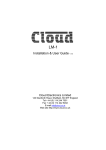
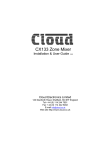
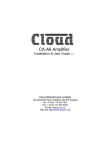
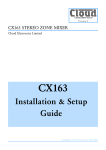
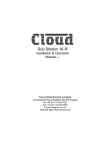
![CX122 User Guide [manual]](http://vs1.manualzilla.com/store/data/006893732_1-737783e5322cb6d4b2fce699c2324b84-150x150.png)
